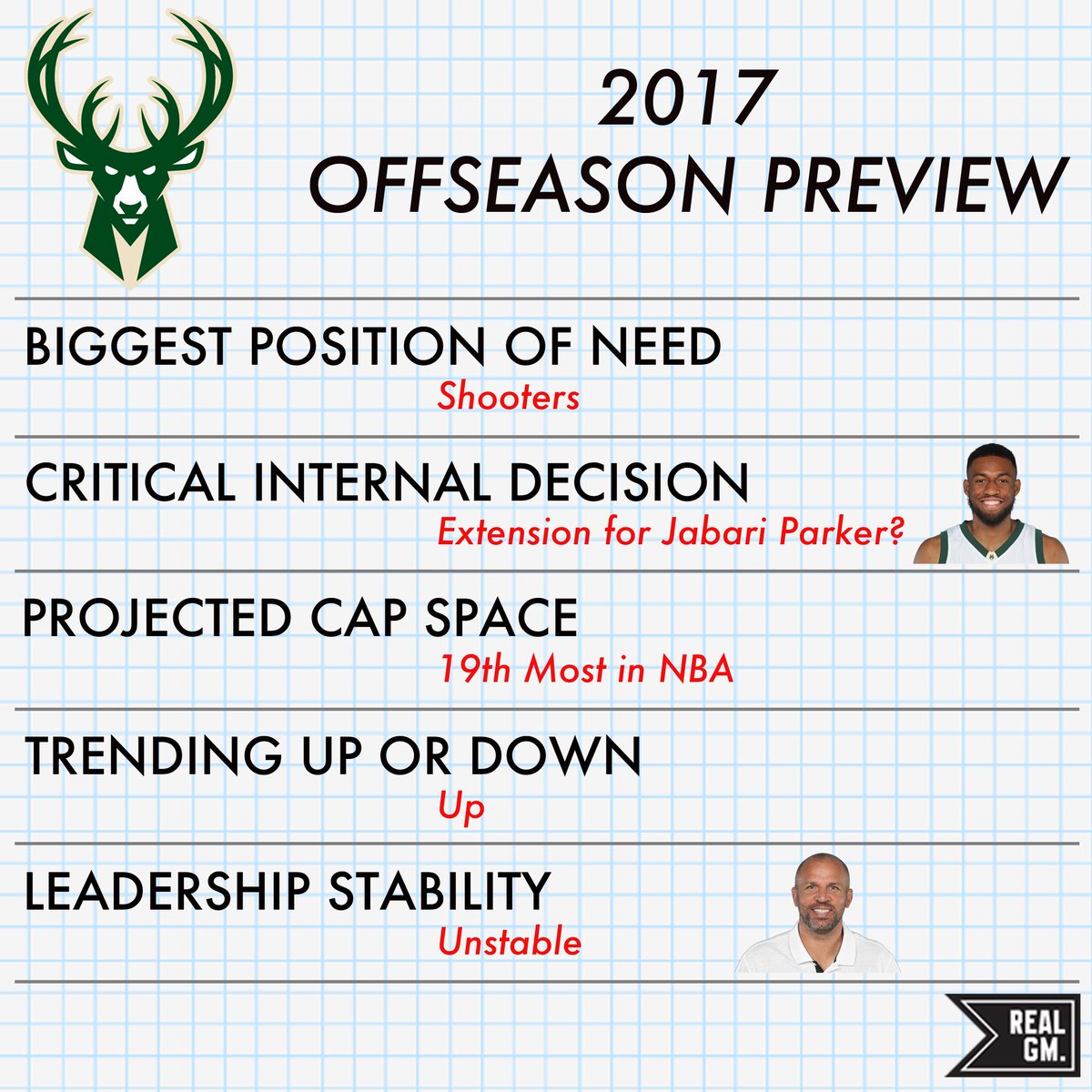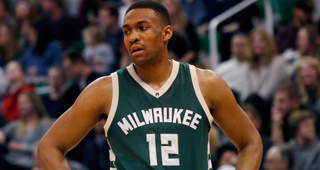The Milwaukee Bucks have made the playoffs in three of the past five seasons, stuck in the trend of “make, miss” from year to year. In each playoff iteration, the Bucks have been under or around .500 during the regular season before losing in the first round. This time around feels markedly different. On the back of a generational talent in Giannis Antetokounmpo, surrounded by good young role players, the Bucks are poised to become a perennial playoff team.
John Hammond picked two eventual starters in Thon Maker and Malcolm Brogdon last June in the draft. Much like Antetokounmpo in 2013, Hammond was criticized for reaching for Maker with the 10th overall pick. After an up and down start, Maker became the Bucks' starting center and even played solid minutes in the playoffs.
Brogdon was a bit of a different story. Hammond and Milwaukee were lauded for selecting Brogdon in the second round, as most thought he would at least be a high-end backup point guard. Instead, Brogdon won the starting job in late December, lost it briefly, and regained the role for the rest of the season in early March. Brogdon averaged 10 points per game on 45.7 percent shooting to go with 4.2 assists per game, while also recording 1.1 steals per game. Brogdon was steady on both ends and proved to be a good fit for the rest of the Bucks' roster and is in contention for Rookie of the Year honors.
When free agency opened, Milwaukee didn’t know what they had in Brogdon yet and were hoping to add a point guard who was a good fit next to a high usage wing in Antetokounmpo. In Matthew Dellavedova, the Bucks found a player who had that exact profile from his time playing with LeBron James. Despite not delivering the defense and struggling to shoot the ball as well as he had with Cleveland, Dellavedova proved to be a good fit for the Bucks. He’s fairly paid as a backup/spot starter and works well with Brogdon as a pairing at point guard.
The Bucks' other big addition in the summer was Mirza Teletovic. Although Milwaukee already had several other big man options, none provided the stretch element that Teletovic was signed to give them. With somewhat inconsistent playing time in a crowded frontcourt, Teletovic struggled to get into rhythm and had an off year shooting the ball. As the big rotation settles, he should rebound to give Milwaukee solid value as a stretch four off the bench.
Following those additions, the Bucks re-signed Miles Plumlee to a four-year, $50 million contract. Plumlee fought injuries for most of the season and couldn’t carve out consistent time with the Bucks' other options up front. He was eventually traded in a salary dump to Charlotte, where Milwaukee did well to clear his long term money from their cap sheet.
The roster was filled out with Steve Novak and Jason Terry as bench veterans, and Michael Beasley was brought in trade to give the bench some scoring ability. Novak had no impact in the rotation and was eventually waived, but Terry and Beasley both had moments as rotation players. Terry played especially well at times in the playoffs, and showed he can still score the ball off the bench.
As the season neared, Milwaukee made two more moves, both of which were more impactful than the Bucks' previous transactions. First was to sign Giannis Antetokounmpo to a four-year, $100 million extension that kicks in at the start of the 17-18 season. Given his emergence as one of the NBA’s best young talents, the Bucks did well to get him on a less than max deal.
The second trade was made a couple of weeks before the season, as Milwaukee lightened up their point guard jam by trading former Rookie of the Year Michael Carter-Williams to Chicago for Tony Snell. At the time, this trade was met with mostly a “meh” reaction around the league, but worked out great for the Bucks in retrospect. Carter-Williams had no place on the roster given the presence of Dellavedova and Brogdon, and Milwaukee had a need on the wing with Khris Middleton out for the start of the season. Snell easily had his best season in the NBA, starting 80 games while shooting over 45 percent overall and 40.6 percent from behind the arc.
Snell is now one of the Bucks' big questions heading into 2017 free agency. As a restricted free agent, it is a lock that Milwaukee will tender Snell a qualifying offer to retain match rights. With Jabari Parker likely to miss time to start the season, Snell is a good fit on the wing with Middleton, giving the Bucks the size, length and shooting they like from the position. Unless he receives a large offer sheet from another team, it is likely Snell and Milwaukee will come to terms on a deal.
The Bucks' other potential free agent of consequence is Greg Monroe. Monroe had one of his better seasons, as he came off the bench all year for Milwaukee. He averaged 11.7 points per game and grabbed 6.6 rebounds per game, while shooting over 53 percent from the floor. It is still up in the air if Monroe will opt in at $17.8 million for 17-18 or test free agency. With a solid role in place as one of the best bench bigs in the league, he may stay in Milwaukee for one more year.
Terry and Beasley could both be re-signed as Milwaukee's other free agents. The Bucks like both as minimum salary bench players. Spencer Hawes, who was acquired in the Plumlee salary dump, could exercise a player option and return as a deep bench big. Milwaukee could waive Hawes and eat the $6 million remaining on his deal if he does opt in.
With most of the roster seemingly set and without significant cap space, the Bucks' next big question revolves around Jabari Parker now that he’s eligible for an extension of his rookie scale contract. Parker was enjoying a breakout season, scoring over 20 points per game on 49 percent from the field and over 36 percent on three-pointers. Parker was also an improved rebounder, especially on the defensive glass. His emergence alongside Antetokounmpo gave Milwaukee the best pair of young forwards in the NBA. Parker unfortunately re-tore his left ACL in February, the same injury that prematurely ended his rookie year.
Prior to the injury, Parker seemed a lock to receive an extension offer that would have likely approached similar territory to Antetokounmpo’s numbers. With Parker unlikely to return from his injury prior to the deadline for an extension, Milwaukee would have to take a large leap of faith that he can rebound from a second torn ACL. Conventional wisdom, given the team’s ability to retain match rights on Parker as a restricted free agent, would be to let him play out the season and then deal with a new contract in the summer of 2018. The challenge is that under the new CBA, the cap holds for players off rookie scale contracts go up significantly. As it stands, the Bucks could be looking at a cap hold for Parker in excess of $20 million. That could limit the team’s ability to add other talent. As it stands, Milwaukee will probably offer Parker an under market deal. Should he decline, the Bucks and Parker will postpone their negotiations until 2018.
The Bucks will likely add the best player available at the draft before taking a cautious approach in free agency. With no glaring holes, outside of hoping their own shooters return to form, Milwaukee can survey the market and take a “whoever is left” approach. This worked out well to sign Terry last year and the Bucks could add another player like him again.
One issue compounding things in Milwaukee is they have yet to hire a new general manager to replace Hammond. Assistant GM Justin Zanik, former Hawks GM Wes Wilcox and Nuggets Assistant GM Arturas Karnisovas have emerged as favorites for the job. No matter who is hired, how they differ in team building philosophy from Hammond will be something to monitor. Hammond may have missed at times with signings, but he made solid trades and generally drafted quite well.
Outside of Parker’s recovery, the new GM walks into a spot where the Bucks are as well positioned as any young team in the league. Most of their young talent is signed for the next few years. They have no truly bad contracts. If Milwaukee is able to avoid taking on bad money and can sign Parker for a reasonable price, they’ll quickly make the jump from playoff team to one that can go deep in the Eastern Conference.
Offseason Details
Guaranteed Contracts (9): Giannis Antetokounmpo, Malcolm Brogdon, Matthew Dellavedova, John Henson, Thon Maker, Khris Middleton, Jabari Parker, Mirza Teletovic, Rashad Vaughn
Partial/Non-Guaranteed Contracts (1): Gary Payton II
Potential Free Agents (5): Michael Beasley (UFA), Spencer Hawes (UFA – Player Option), Greg Monroe (UFA – Player Option), Tony Snell (RFA), Jason Terry (UFA)
“Dead” Money on Cap (1): $1,865,546 (Larry Sanders)
First Round Draft Pick(s): Pick #17
Maximum Cap Space: $15,917,459
Projected Cap Space: None. $17,852,279 over




